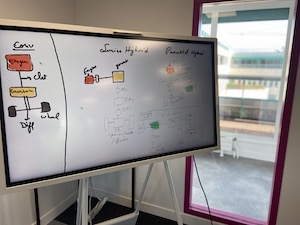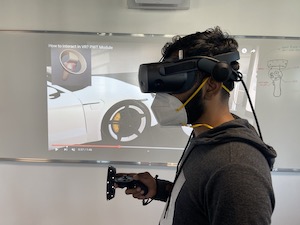Interview with Ludivine Pidol, Supervisor of the "Electric, hybrid and IC powertrains" Advanced-master degree®, El Hadj Miliani, lecturer in the Powertrains and Sustainable Mobility Center, and Clément Cahagne, Head of the Educational Innovations and Immersive Realities Hubs at Lab e·nov, the digital culture laboratory supporting IFP School and IFPEN Group.
Immersive content is becoming an increasingly important component of IFP School’s programs. In May, supported by Numix, a company based in the Tarn region of southwestern France, a team of teachers at IFP School’s Powertrains and Sustainable Mobility Center and Lab e·nov began developing two new virtual reality modules on the theme of electric and hybrid powertrains.
The two modules are aimed at all of the Center’s programs, i.e., the three specialized engineering programs (Energy and Powertrains, Powertrain Engineering, Energy and Products), the "Electric, hybrid and IC powertrains" Advanced-master degree® program and the "Electrification and Automotive Propulsion" research-oriented master's program.
The first versions were rolled out and tested at the end of October by students on the Powertrain Engineering (PWT) and Energy and Powertrains (MOT) programs.
1. Why did you decide to create these modules?
Ludivine Pidol: At the start of their courses, students enrolled in the Energy and Powertrains (MOT) and Powertrain Engineering (PWT) programs undertake a four-day training course during which they learn how to assemble an IC engine at the Groupement National pour la Formation Automobile (GNFA, the French National Automotive Training Group).
An equivalent course geared towards electric engines would require specific electric accreditation due to safety standards. We’re talking about a high-voltage environment. There is more to it than just wearing safety shoes and gloves!
These two new virtual reality modules complement the practical work accomplished by interns at the GNFA and enable our students to safely learn and reproduce the steps involved.
2. What do these modules consist of? What are the learning objectives?
El Hadj Miliani: These modules fall within the framework of the “electric and hybrid vehicles, batteries and transmissions” teaching module common to both programs.
The interactive and immersive content complement the traditional practical application workshops. Our objective is to enable students to examine an electric and/or hybrid powertrain in a safe, low-cost environment as close as possible to the real world. Our educational approach is based on three steps: learn, validate, do. We want to propose a different learning experience in which students feel more engaged with their training.
In October and November, following theoretical modules covering electric and hybrid vehicle technologies, PWT and MOT program students were split into smaller groups of ten and went to work at Lab e·nov’s new premises.

|

|
There were two components to the module. Students began by working in the "Active Learning Rooms" set up at Lab e·nov and reproduced electric and hybrid powertrain architectures on digital screens, in diagram form, as presented during the theory components of their programs. The idea was to allow students to revise some of the concepts and reactivate their knowledge! Then, equipped with virtual reality headsets and controllers, students applied their knowledge via three activities: a first activity during which they had to identify the various components of the electric or hybrid powertrain (batteries, power electronics, electric powertrains, etc.), followed by a second in which they had to rebuild a powertrain using elements set out on a workbench. They repositioned them on a bare chassis and then completed the cabling, taking into account the technical constraints and electrical risks.
Thirdly, students were also able to visualize the power and energy flows depending on the different vehicle operating modes (traction, energy recovery, recharge, etc.): an invaluable aid in terms of obtaining a global understanding of these complex systems!
3. What steps were involved in the design process for these modules? And what early feedback have you received?
Clément Cahagne: Having come up with and constructed scenarios for the virtual reality learning activities, we worked closely with Numix, a company specializing in the design of immersive learning capsules.
In order to achieve a realistic effect, we provided them with various educational materials, images and videos of the different elements to be developed in a 3D environment, as well as diagrams of the components making up the two electric and hybrid powertrains.
While we were developing the modules with Numix, we also worked on the overall format of the course. It is very important to ensure virtual reality sessions using the headsets are backed up by periods spent in lecture theaters, briefing and debriefing sessions both downstream and upstream of immersive phases, or activities conducted in working groups. Used as a stand-alone tool, without supervision and without a well thought-out educational direction, immersive modules lose their value and the overall learning outcome suffers as a result!
We conducted a survey of around sixty students in order to get their feedback and make the necessary improvements to the modules.
A third virtual reality module focusing on batteries is also in the process of being developed. The idea is to enable students to visualize all of the components making up a battery pack. The latter is often likened to a “black box” providing the energy required to power the electric vehicle; virtual reality will help students understand this vital component by constructing it from scratch!
Interview conducted by: Meyling Siu